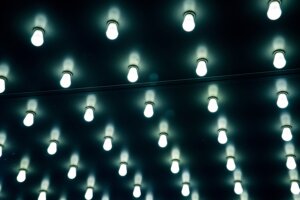Mercury in Fluorescent Lighting: Consumer Action
kristiet_a0o04rjz
on
December 1, 2021
Mercury in Fluorescent Lighting: Consumer Action
By Kathy Attar, Program Manager, Eco-Healthy Child Care®
December 2021
Mercury is a potent neurotoxin, yet is still used in all fluorescent lighting. There is no “safe” level of exposure to mercury. Switching to mercury-free LEDs in child care settings will reduce hazardous exposures, lower electricity bills, and protect the environment from harmful air pollutants.
The Clean Lighting Coalition, in partnership with the Mercury Policy Project and Responsible Purchasing Network, developed a new report, Mercury in Fluorescent Lighting: Unnecessary Health Risks & Actionable Solutions, highlighting the environmental and health risks posed when fluorescents break, especially to children. CEHN co-released the report which provides steps government officials, consumers, and child care providers can take to accelerate the transition to LED lighting.
Infants and young children are most vulnerable to the negative health effects of mercury because their brains are still developing. Reducing exposures is key to protecting their health.
Mercury is a naturally occurring heavy metal that is released into the environment via industries such as mining, incineration, and coal-burning. These activities emit mercury into the air, some of which then settles into soils, streams, and oceans, where it is changed to methyl mercury. Once methyl mercury is in the water, it increases in concentration as it moves up the food chain, with higher levels in big, long-lived fish. Humans that eat these fish are then exposed to mercury. For further information about reducing mercury exposure in food read our EHCC mercury fact sheet.
Mercury is also released into the environment when mercury-containing items such as batteries, compact fluorescent light bulbs, and tubes, and mercury thermometers and thermostats break or are thrown away improperly.
Why switch to LEDs?
- LEDs are more energy-efficient and do not contain hazardous mercury. LEDs are approximately 50% more energy-efficient and last 2-3 times longer than fluorescents and other traditional lighting products.
- They emit less mercury and other harmful air pollutants from coal-burning power plants because of their energy efficiency and lasting power.
- Across the US, LEDs are widely available in supermarkets, hardware stores, retail and online shops.
- LEDs are a cost-effective alternative to fluorescent lighting.
The Mercury in Fluorescent Lighting report outlines actions consumers can take to reduce mercury exposure in lighting in homes and child care settings:
- Replace all fluorescent lighting equipment with LED lamps, retrofit kits, and luminaires.
- Replace incandescent and halogen lamps with LEDs to lower electricity bills and reduce emissions from power plants.
- Ensure that fluorescent lamps are disposed of properly.
- Advocate for federal, state, and local policies to phase out the manufacture and sale of fluorescent lamps in the United States –hastening the transition to LEDs.
Take our Protecting Children’s Environmental Health E-Course to learn more about reducing children’s unnecessary exposure to mercury, as well as other great tips for keeping children and child care staff safe from environmental hazards like pesticides and unsafe plastics in child care settings.
Mercurio en la iluminación fluorescente: acción del consumidor
El mercurio es una neurotoxina potente, pero todavía se utiliza en todas las iluminaciones fluorescentes. No existe un nivel “seguro” de exposición al mercurio. Cambiar a LED sin mercurio en entornos de cuidado infantil reducirá las exposiciones peligrosas, reducirá las facturas de electricidad y protegerá el medio ambiente de los contaminantes nocivos del aire.
La Clean Lighting Coalition (Coalición de Iluminación Limpia), en asociación con el Mercury policy Project and Responsible Purchasing Network (Proyecto de Política de Mercurio y la Red de Compras Responsables), desarrolló un nuevo reporte, Mercury in Fluorescent Lighting: Unnecessary Health Risks & Actionable Solutions (Mercurio en la iluminación fluorescente: riesgos innecesarios para la salud y soluciones procesables), destacando la salud ambiental y los riesgos planteados cuando se rompen los fluorescentes, especialmente a los niños. CEHN co-publicó el informe que proporciona los pasos que los funcionarios gubernamentales, los consumidores y los proveedores de cuidado infantil pueden tomar para acelerar la transición a la iluminación LED.
Los bebés y los niños pequeños son los más vulnerables a los efectos negativos del mercurio en la salud porque sus cerebros aún se están desarrollando. Reducir las exposiciones es clave para proteger su salud.
El mercurio es un metal pesado de origen natural que se libera al medio ambiente a través de industrias como la minería, la incineración y la quema de carbón. Estas actividades emiten mercurio al aire, parte del cual luego se deposita en suelos, arroyos y océanos, donde se transforma en metilmercurio. Una vez que el metilmercurio está en el agua, aumenta su concentración a medida que avanza en la cadena alimentaria, con niveles más altos en peces grandes y de larga vida. Los seres humanos que comen estos peces están expuestos al mercurio. Para obtener más información sobre cómo reducir la exposición al mercurio en los alimentos, lea nuestra hoja informativa sobre el mercurio.
El mercurio también se libera en el medio ambiente cuando artículos que contienen mercurio, como baterías, bombillas y tubos fluorescentes compactos, y termómetros y termostatos de mercurio se rompen o se desechan de forma incorrecta.
¿Por qué cambiar a LED?
- Los LED son más eficientes energéticamente y no contienen mercurio peligroso. Los LED son aproximadamente un 50% más eficientes energéticamente y duran entre 2 y 3 veces más que los fluorescentes y otros productos de iluminación tradicionales.
- Emiten menos mercurio y otros contaminantes atmosféricos nocivos de las centrales eléctricas que queman carbón debido a su eficiencia energética y su poder duradero.
- En los EE. UU., los LED están ampliamente disponibles en supermercados, ferreterías, tiendas minoristas y en línea.
- Los LED son una alternativa rentable a la iluminación fluorescente.
El reporte Mercury in Fluorescent Lighting (el Mercurio en iluminación fluorescente) describe las acciones que los consumidores pueden tomar para reducir la exposición al mercurio en la iluminación de hogares y entornos de cuidado infantil:
- Reemplazar todos los equipos de iluminación fluorescente con lámparas LED, kits de actualización y luminarias.
- Reemplace las lámparas incandescentes y halógenas por LED para reducir las facturas de electricidad y reducir las emisiones de las plantas de energía.
- Asegúrese de que las lámparas fluorescentes se eliminen correctamente.
- Abogar por políticas federales, estatales y locales para eliminar gradualmente la fabricación y venta de lámparas fluorescentes en los Estados Unidos, acelerando la transición a los LED.
Tome nuestro curso electrónico Protección de la salud ambiental de los niños para obtener más información sobre cómo reducir la exposición innecesaria de los niños al mercurio, así como otros excelentes consejos para mantener a los niños y al personal de cuidado infantil a salvo de peligros ambientales como pesticidas y plásticos inseguros en los entornos de cuidado infantil.




